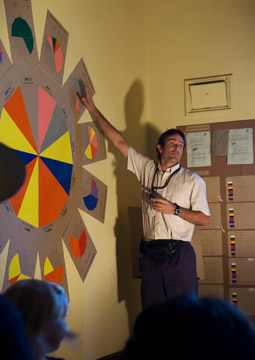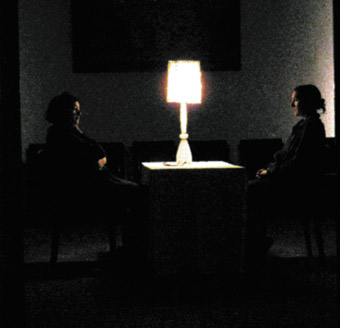frame shifters
barry laing: in-habit, abbotsford convent, melbourne

Jason Maling, Triangulation, Second last audit session, In-Habit
photo Tara Gilbee
Jason Maling, Triangulation, Second last audit session, In-Habit
IN-HABIT WAS AN EXCEPTIONAL, INVENTIVELY CURATED MONTH-LONG SERIES OF 11 PERFORMANCE, LIVE ART AND INSTALLATION WORKS SITUATED IN AND AROUND THE ABBOTSFORD CONVENT. INVOLVING NINE KEY ARTISTS, MORE THAN A DOZEN ASSOCIATE ARTISTS AND NUMEROUS PARTICIPANTS, THESE ARTWORKS EMERGED OUT OF A COLLECTIVE RESIDENCY AT THE CONVENT ESTABLISHED BY ARTISTIC DIRECTOR JUDE ANDERSON EXPLORING SITE/PLACE/SPACE AND CULTURAL EXCHANGE.
In One Square Metre the Atherton Community Gardens in Fitzroy are opened to the public for a ‘tour.’ We are greeted in the heat and vibrancy of colour and scent amidst 60 garden beds by Zeynep, a Turkish Australian resident of nearby high rise flats and gardener here since 1969. Zeynep offers everyone dolmades, produce from her garden and the recipe! Jude Anderson serves water and introduces the project and tour. Over 12 months she has cultivated one square metre of garden according to some of the principles of French landscape architect Gilles Clément’s notion of the Planetary Garde: use only seeds offered or found, and no planting—sow as the wind would sow. While also adopting existing rules and practices from the gardeners at Atherton, Anderson’s alternative aesthetic, ethical and ecological practice brought her into immediate, humorous, productive ‘conflict’ and exchange with Zeynep and other Atherton gardeners: bed-ends framing their gardens, a living lattice of wild willow framing hers; theirs organised on pragmatic principles, hers a micro-cosmos of chaos. Anderson, the ‘hopeless gardener’!
It is the fruits of these meetings with community members and the growth of their interactions over time that are made available to us on the tour. Zeynep leads as Anderson and others draw her into conversation. We are introduced to vagabond plants, ‘weeds’, not normally cultivated. Dandelion, for a peppery salad. An Italian woman attending the tour confides, “We survived the Second World War on it. Really, a whole population.” Purslane, common in cracks in the pavement, we learn, is good for constipation. Something of a delicacy in Turkey, the Italians use it in a chicken breast salad. Another tour member tells us it is also being trialled in cardiovascular research. Ah, my vagabond heart! In a kind of culinary ecstasy, we taste, inquire after, debate and receive recipes for Black Sea Cabbage, Sawtooth Coriander, French Sorrel, Stinging Nettle and more.
The work of One Square Metre literally overflows its frame. It is a living artwork and residency in which Anderson creates the conditions for new encounters, competing knowledges, curiosity and exchange. The ‘art’ of the event surpasses her tiny plot of unruly garden, arises in layers of complexity and finds form in genuine reciprocity and learning.
In Triangulation, Jason Maling and Torie Nimmervoll are Colour Auditors. For 12 long days they conduct a ‘prismatic audit’ of the vast Abbotsford Convent. ‘Audit kits’ comprising small coloured flags on poles to be stuck outside room doors are distributed to residents at the convent (staff, artists, health practitioners etc). Participants may change the colour of their flags at any time, on any impulse, for any reason. No prescription is given. At regular intervals throughout the day, Maling and Nimmervoll painstakingly collect and collate the ‘data’ (the colour of the flags) for individual rooms, different floors, separate wings and the convent as a whole. They fashion the results—sectioning, cross-referencing, averaging—into cumulative line graphs and pie charts and present their ‘findings’ to the 50 participants and public in twice-daily ‘briefings.’
These wry, deadpan, faux analyses of the changing colours of the community amuse in their ludicrous seriousness. A possible “politics of Orange” in the East Wing countered by, perhaps, a “collaborative gathering of Green” in the West Wing could, potentially, be the sign of a stand-off! The doubtful sighting by Maling of a blue-tongue lizard in the convent grounds on the very day the data for the whole Convent came up Blue—well, “that was definitely a sign”! But there are no causes, only significances. These briefings are not the most significant aspect of the work. The frame slips. As convent participants are drawn into discussion and gregarious interaction with the performers, it becomes clear that these exchanges are made possible by the live, cumulative progress of the work in which the ‘audience’ have been participants and performers—in chance encounters, meetings, discussions, email exchanges and (suspiciously) clandestine activities — for 12 days. Repetitive and ritual structures already dispersed throughout the project coalesce in these briefings as the participants congregate to share in and further create the work; less to watch a performance than to keep the performance, and themselves, in play. The work finds its significance in the ‘community’ that it helps to form.

Once, In-Habit
photo Thomas Kokkinos-Kennedy
Once, In-Habit
Katerina Kokkinos-Kennedy’s Once shifts the performative frame still further. It is a live artwork for two people. Participants, strangers to each other, agree to meet in silence for 10 minutes. They are then invited to share their experiences of the encounter in recorded conversations, separately, with two ‘ushers.’
There is a strange, aberrant tension in the convent’s Bishop’s Parlour. The age and restraint of the space and its imagined histories (vows of silence, ‘audiences’ with the Bishop) creep into the experience. I am seated by an usher at a small table with a lamp in the centre of the room. Left alone for a long moment, the tension is interrupted by the entrance of another. A woman sits and establishes direct eye contact. The lamp is flicked on by the usher. The shadows in the room retreat and harden. Silence.
Fast mind. Rapid passage of thoughts and images. Discomfort manifests in smiles and corsetted laughs. We look at each other and away to the edges of the spongy darkness. Our gaze returns to the stranger opposite—often, more often. Time slows. Somehow we begin a conversation in writing. Are we breaking the rules? What is forbidden? What is allowed? We relax into a playful meditation on the nature and quality of silence. An usher enters…the stranger is gone.
Subsequently, sharing experience with the usher is also charged—it too has its intimacies. Like the first stranger, the usher becomes the human face of an unknowable structure that refuses revelation—of intent, meaning and significance. Here, the work of the piece continues and takes the form of a kind of ‘confession’ of experience and of unusually open avowal.
The silence, the site and the two meetings form and frame the ‘work’ of the piece and its artifice, the pretext of its enquiry. Beyond this, the piece works ‘in’ the participants. Each stranger becomes the site at which a kind of alchemical fusion of projection and introspection lifts itself into consciousness. The work functions as a hiatus, a pause by means of which to see and experience another, to feel habitual avoidance, looking and being looked at, to sense movement towards and away from each other and all of the electricity, e-motion, ethics and responsibility of that…just once.
With In-Habit, Jude Anderson, in close collaboration with key artists, achieves an exciting balance between contemporary art, community project and cultural exchange. The project’s success to date is in its ‘smarts’: an articulate, self-questioning agenda which sets up structures with fluid, mutable frames that generate, ‘hold’ and make possible a range of encounters and events with art-making at their heart. The work is engendered and embodied by the network of participants involved—in a particular project, at a specific site, in an existing community, or in those still in formation.
Punctum, In-Habit, artistic director Jude Anderson; Jude Anderson, One Square Metre, associate artists Tara Gilbee, Cedric Peyronnet, Jacques Soddell, Atherton Community Gardens, Feb 11; Jason Maling & Torie Nimmervoll, Triangulation, Landing Lounge West Wing, Feb 15-26, Katerina Kokkinos-Kennedy, Once, associate artists Suzanne Kersten, Clair Korobacz, Bishop’s Parlour, Feb. 6-7; Abbotsford Convent, Melbourne, Feb 3-28, http://www.punctum.com.au/inhabit.html
RealTime issue #96 April-May 2010 pg. 33






